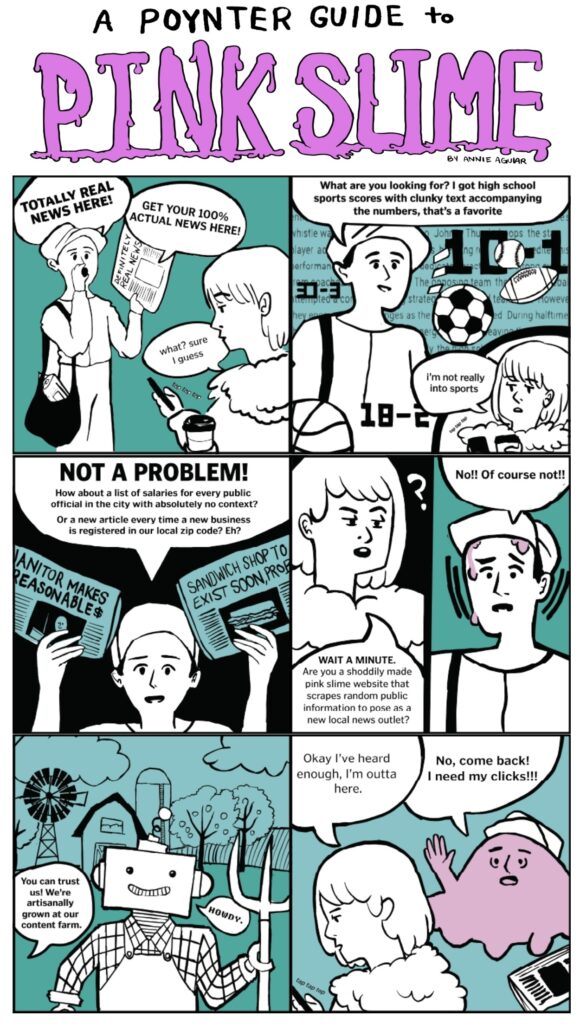
Graphic by Annie Aguiar of the Poynter Institute. Click on image to go to the source at Poynter.org.
Back in 2012, American consumers were grossed out by stories that found ground beef sold in plastic chubs was often supplemented with the meat byproduct euphemistically known as “finely chopped beef.” This collection of “trimmings” is sprayed with ammonia gas to kill off the bacteria in meat and fat. Accompanied by unappealing photos, this “finely chopped beef” was dubbed “pink slime” by critics, a label the meat industry fought largely unsuccessfully against.
Journalist Ryan Zickgraf first applied the term “pink slime” to journalism back in 2012, when he was reporting on how content farms were using low-paid writers located in the Philippines to rewrite (i.e., plagiarize) stories published on other sites. Annie Aguiar, writing for Poynter, a journalism think tank, says that “pink slime” has more recently been used to describe automated websites that publish poor-quality news stories and political propaganda while pretending to be high-quality local news sites. They often thrive in areas that are news deserts with few other legitimate news outlets. Former Washington Post media analyst Margaret Sullivan talks about how this variant of fake news has become popular:
Increasingly, “articles” that look like news may be something entirely different—false or misleading information grounded not in evidence but in partisan politics, produced not by reporters for a local newspaper but by inexperienced writers who are paid, in essence, to spread propaganda.
As an example, Sullivan pointed to a story published on the West Cook News website, serving the suburban Chicago area, that claimed without evidence that a local school district would “require teachers next school year to adjust their classroom grading scales to account for the skin color or ethnicity of its students.” This story, which had no basis in fact, then got picked up by bloggers and social media influencers and spread across the country with predictable levels of outrage. The school district completely denied the story. While some of the people who shared the false story issued corrections or took down their posts, the story still spread.
Columbia Journalism Review (CJR) investigated the ownership and funding of these pink slime sites, finding that the network Metric Media, largely funded by conservative advocacy groups, operates more than 1,200 local news sites across the United States. CJR reported that a group of these sites would write again and again about favored political issues, repeating the same talking points, while completely ignoring major stories like hurricanes and wildfires affecting to local area.
- An August 2024 update on the nonprofits and PACS that spent $14 million on the Metric Media network in 2021-22 from Columbia Journalism Review.
- History of Pink Slime Journalism and media manipulation from Columbia Journalism Review.
Brian Timpone, one of the publishers for Metric Media, operated an online portal in 2023 that allowed political operatives to request stories and submit opinion pieces to be published on his sites designed to look like legitimate news pages in “communities where there is ‘little or no local news.’”
Until recently, pink slime sites have been powered by stories created by low-paid writers working in so-called content farms. But now generative artificial intelligence (AI) programs such as ChatGPT are being used to completely automate the process, creating hundreds of stories a day for these sites.
UPDATE: Pink slime sites have not gone away in the months since this was first posted. In fact, AI-powered pink slime sites continue to grow, infesting people’s news diet.
Nieman Lab ran a big story in January of 2025 about a network of AI-generated newsletters that operate as Good Day News. The AI-engine scans everything it can find about the community and turns it into brief, positive stories. In essence, Good Day takes the work done by local newspapers, radio stations, TV stations, and independent digital outlets It then repackages the information and sells advertising to go with it.
The newsletters have testimonials that go with them. Local news publishers say the endorsements are fabricated. The publisher of the newsletters denies this, saying the names “anonymized” and the quotes “sanitized amalgamations of some of our favorite (and most common) testimonials.”
(Hmmm… I know what I would say to a student who made those statements.)
I highly recommend reading Andrew Deck’s story and would argue that this is a perfect example of pink slime journalism, even though Deck does not use the term.
Have you encountered pink slime sites? Leave a comment below!
